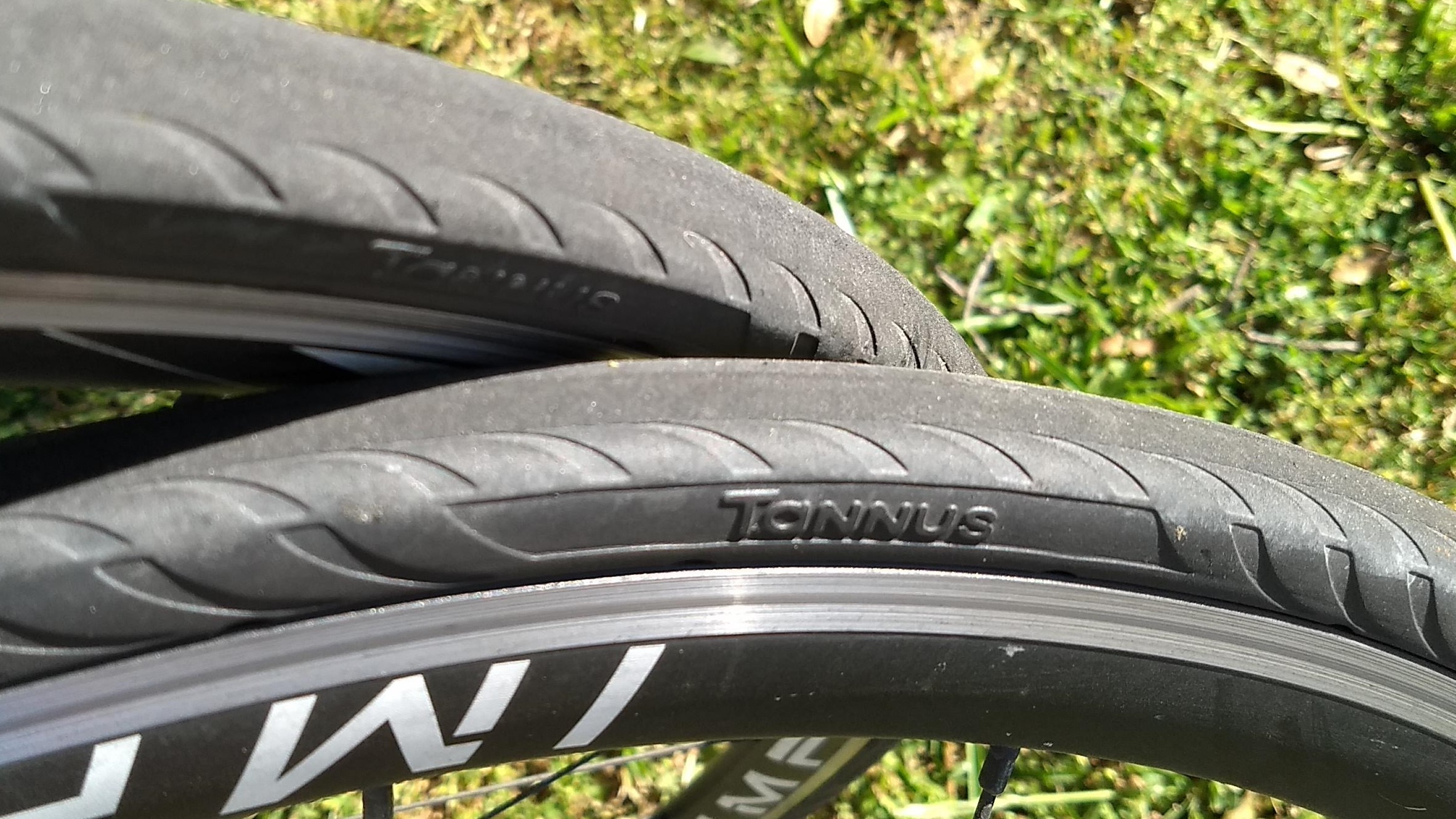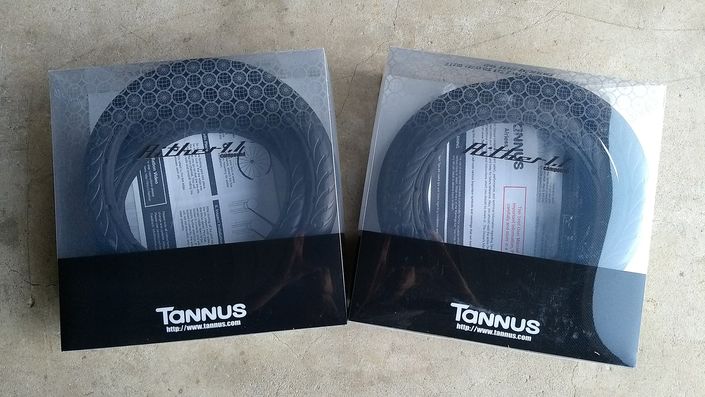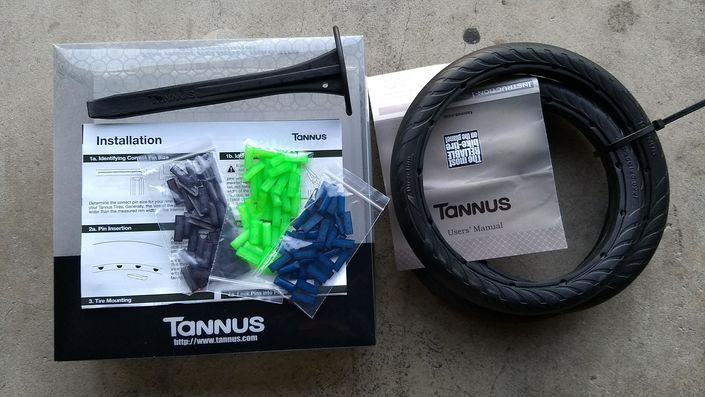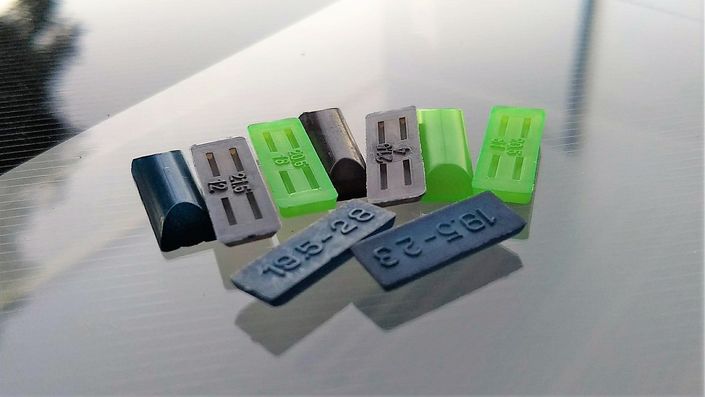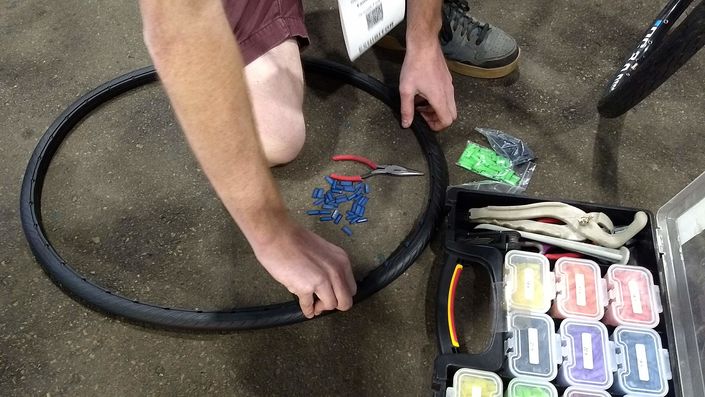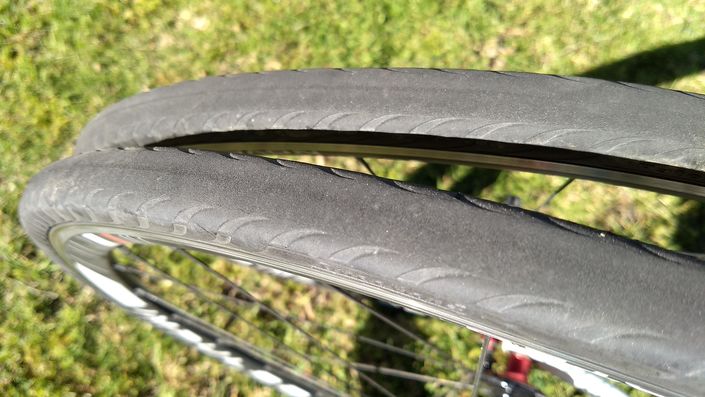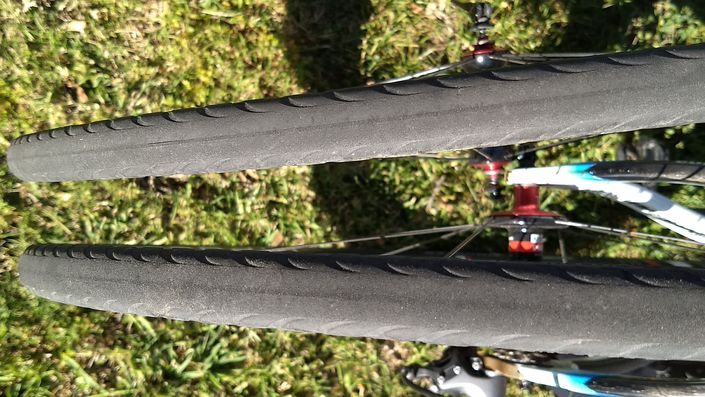Tannus's opening promise is alluring to any cyclist — 5,000 flat-free miles guaranteed. It's because we'll get about half that from a typical road tire and more so because we know in 5,000 miles there's bound to be a few, if not handfuls, of flats / punctures. However, if durability and flat avoidance were the only factors, we'd all be riding solid rubber tires, but those prove impractical for cycling because of their weight, reduced ride comfort, and added rolling resistance. That's where Tannus really got our attention, by claiming their tires were of comparable weight and handling with minimal resistance.
After a short test ride on some Tannus tires at last year's Interbike, we were impressed enough to get a pair to see for ourselves how the Tannus airless tires would live up to the claims on some real rides over time.
We tested the Tannus New Slicks, 700c road tires available in 23, 25, and 28 mm widths, and in three "pressures" — "soft" 95 psi, "regular" 100 psi, and "hard" 110 psi — which are actually firmness profiles of the tire material that Tannus calls Aither 1.1, their patented, puncture-proof resin.
I measured my inner rim width (17 mm) and took into consideration my typical tire pressure and decided to have a go with a pair of New Slicks in 700x25 at regular (100 psi).
The tires arrived in nice packaging and with everything needed to install. Each plastic box contained a tire, 3 sets of locking pins (different colors for different widths to fit different width rims), installation tool, user's manual, and instructions that are nicely supplemented with info and installation videos on the Tannus website.
Installation
I peeled off the regular tires, tubes, and rim strips on a set of aluminum wheels. Tannus recommends taking off the rims strips as they can obstruct installation. They also take the usual tire, tube, and rim strip into account when saying their tires are comparable in weight, in this case 395 grams. Though an average tire and tube and rim strip are probably going to weight less, the claim comes close, if not better, if you also take into account an extra tube and tire levers and mini pump or CO2 you get to leave behind.
After testing each of the three pins to determine which fit best in my rim's channel, I settled on the 19.5 mm blue ones and set about inserting them into the tires. Each tires requires 40 pins; it wasn't hard, but a bit tedious. Tannus includes a few extra in case you drop and lose some during the process or happen to break one.
Getting these tires mounted onto the rims wasn't for me and probably isn't for an average cyclist. I've installed hundreds of tires and have had my run-ins with tough, tight ones, but I could not install these Tannus tires myself. I read the instructions, watched the videos, and even reached out to Tannus directly for some guidance. The tires were super-tight in spite of the pre-stretching I did, making it really tough just to get them around the rim. After that, I was not having success locking the pins into place. My wimpy forearm strength wasn't enough and my technique must've been wrong.
Unable to do it myself, I was about to take them to a local bike shop and Tannus dealer for a pro install — about $25-30 for the pair, which would be totally fair and worth it. However, I noticed I'd be seeing the Tannus folks at CABDA West the next week, so I brought the wheels and tires there so they could show me. David Ballard, Tannus co-founder, and Sterling Petersen, National Sales Director, explained that it does take some technique to get the pins pushed in, and there's a special tool, P-Tool Pliers, dealers can get and use to make it easier. They also acknowledged that my rims did seem unusually challenging as they both showed off their experience to make quick work of getting the tires locked into place.
Ride Impressions
Once on the rims, the tires look normal. Someone looking closely might notice the small gaps where the pins go into the tire. The New Slicks come in 12 different colors, so a bright pink tire, as one example, would certainly catch attention, which is why we went with traditional black — to see if anyone else would notice, and they never did.
At low speeds, 15 MPH or slower, there's not a huge difference between the New Slicks and regular tires. Added resistance at those speeds isn't felt much, and there's some harshness in the solid tire ride, but not bone rattling. Upwards of 15 MPH, the resistance is more noticeable and starts to really eat into your legs above 25 MPH or on the uphills. Tannus says it's an 8% rolling resistance, but it felt like 10-15% at the beginning. Still, these are way better than the solid tires we've tried years before.
Tannus tires have a break in period of 50-70 miles. It was apparent on the first few rides, with the tires feeling rigid and plastic-like, most notably in cornering. As I got past those initial miles, the tires started to feel much more normal, save for the extra resistance and harshness.
One concern I got over early was whether the tires would stay put or perhaps spin on the rim or rattle about. I started out riding them cautiously, worried that it might happen, but as the miles went by it was never an issue and I can see now the tires are well fitted to the rims in what seems just as good a way as regular tires.
Grip is impressive, even in the wet. These tires are on par with most for wet or dry, and while I eased into it gradually, they even have me trusting them when cornering at speed.
Air pressure for "regular" at 100 psi feels accurate. I was satisfied with the relative firmness and ride quality. Results will vary based on rider and bike weight. It's tempting to want "hard" 110 psi, expecting decreased rolling resistance, but I'm not sure the harshness trade-off would be worth it.
Rolling out for a ride got a couple of minutes quicker each time thanks to these airless tires, except for the one time I grabbed a pump and searched in vain for the valve stem, only to realize I wouldn't find one! Otherwise, you don't have to pump up, just grab and go.
Riding without worrying about flats is quite nice, no surprise there. What is surprising is that Tannus tires make riding out on the roads a little bit safer, too. How so? I noticed it especially after the rain, when there would be more debris on the side of the road. On regular tires, I might have to dodge more or move out into the traffic lane to avoid, but with airless tires I didn't have to worry about riding through the stuff that might normally cut a tire or cause a puncture, and I reduced my exposure to dangerous traffic.
Are Tannus airless tires right for you?
Part of answering this questions is math, kind of like when I answered if it's worth patching tubes? Tannus tires are $80 each, and if you get installation (I recommend it) at $30, I'll assume some sales tax and figure you're in for $200. Compare that to a pair of Continental Gatorskins at $45 each and a pair of tubes at $7.50 each for $105 total, and you're looking at Tannus being almost twice as much initial cost. However, that's going to be recouped if the Tannus tires last twice as long — 5,000 miles guaranteed — and with just a few tubes that you're more than likely to need along the way on regular tires. Sprinkle in time saved not pumping up each ride and from fixing flats, and you could easily come out well ahead on the Tannus investment.
What's going to be more of a factor in your decision is the rolling resistance and harsher ride. There's no getting around it, that's the real trade-off. If you're a commuter, Tannus tires definitely feel like a good move — accept a little more resitance and harsher ride for all the other benefits.
For regular riders and racers, the rolling resistance can be a bigger challenge. I definitely feel a bit sluggish on them, as if riding into a headwind. I figured out, though, that Tannus tires make for fantastic training. I don't worry about getting and stopping for flats and I am forced to work harder, making me stronger. I did have to swallow some pride at first when the group rides got fast and I struggled to overcome the difference, but if the goal is to get stronger and faster, it's happening with each pedal stroke. I feel like I'm flying when I get back on regular tires.
Final Thoughts and Notes
Once Tannus tires are on, they don't come off easily and are intended to only be removed once used up. We think they work great on a dedicated commuter bike, or on a secondary set of wheels. What we wouldn't do is put them on our only set of road wheels and definitely not any carbon wheels because the tires' attributes conflict with the benefit of carbon wheels and because the installation could compromise delicate carbon. Tannus must've heard us, because they're currently offering New Slick tires and alloy wheel combo with the tires pre-installed for $249. If you don't already have a training wheelset, this is a way to get one for just $75 more than the tires alone.
I still put a spare tube and mimi pump in my pocket most rides. I might not need them, but my ridemates or a stranded rider along the way might. It's training weight!
What about tubeless? Isn't that better? For us, road tubeless still requires too much work and hassle to be worth it. It's not fully puncture-proof, so while sealant can close up on small punctures, bigger ones are still an issue. It's messy and the tire can still get damaged beyond use.
Tannus tires aren't meant for off-road — dirt and gravel. Doing gravel increases the chance of putting "pits" in the tire and a lot of those may degrade the ride quality. Luckily, Tannus has been working on that front, recently introducing Tannus Armour, inserts for your existing gravel or MTB tires for protection and performance. We've reviewed foam tire inserts before and are looking forward to giving Tannus Armour a try. Watch for the upcoming review.
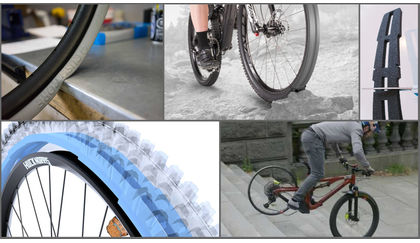
RELATED ARTICLE:
Foam tire inserts and the future of MTB wheels
Looking to get into time trial or triathlon and unsure whether to do it on your road bike or to fork out money for a real TT bike? Here is the answer... READ MORE
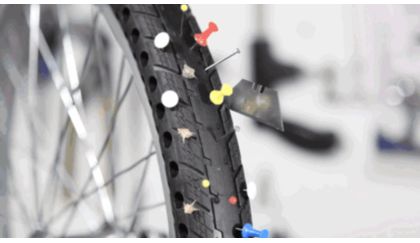
RELATED ARTICLE:
Puncture proof my road bike tire
Cycling's world governing body is poised to allow motorized bicycles in select events next year... READ MORE
